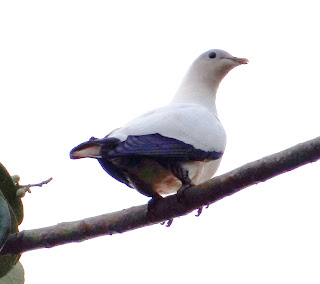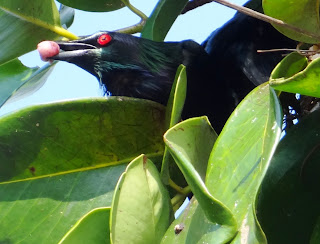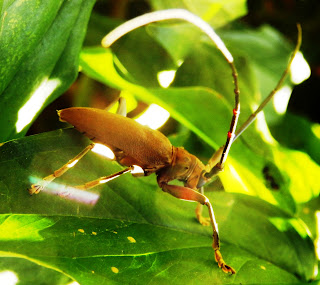Sunrise is the best time of the day. Not only is it cooler, a welcome relief at this time of the year, it is the time when shore-birds are most active.
As the sun's light slowly lifts the shadows from the beach the shore-birds appear. They arrive as if from nowhere, some flying low in over the water, others descending from the sky and yet others arrive in a run from the sand dunes behind the beach.
A grey-tailed tattler and a common sandpiper appeared on the dead stump of a tree. The bird's shadows were reflected in a pool of water. The black stump shaped like a giant crocodile about to leap and eat the tattler. Also reflected in the water the dead trunks of the old mangrove forest, they appeared to ascend from the waters dark, depth like legs of long, lost souls.
Only at the very beginning of the day can you find this magic.
A rainbow bee-eater sat on the branch of a leafless mangrove, her head lifted to the sky, the sun bathing her chest.
She sprung into the air and snap, snap. A swarm of bees searching for nectar became rainbow bee-eaters breakfast. She had been waiting in ambush, not sunbathing.
The female bee-eater's two central tail feathers are shorter than the males.
I walked back to the nursery and saw, in a clearing, cassowary Jessie stretching her body to full height in dominance. Snout was drumming in distress, Jessie has fallen out of love.
 Poor Biggles, the territorial disputes are on and he is last in the pecking order: chased by Jessie, Snout and Dot. However, he seems to have made up his mind he wants to stay here and I see him every few days somewhere around the Point.
Poor Biggles, the territorial disputes are on and he is last in the pecking order: chased by Jessie, Snout and Dot. However, he seems to have made up his mind he wants to stay here and I see him every few days somewhere around the Point.
When Dot turned up they were amazed. Curly and Siri from Mele Village, Vanuatu I hope you enjoy your stay in North Queensland and have lots of stories to tell about our big birds.
I was able to identify the cassowary dad as 'Brown Cone'. Unfortunately one of the chicks was hidden by the long grass and when I approached to get a closer shot, they disappeared into the rain forest.
 I was really excited when coming home from town on Monday, walking across the road near the Ninds Creek Bridge was a cassowary I had never seen before, a female I think. Her wattles are quite long so she must be a good age. Perhaps she is 'Brown Cones' mate as he hangs out in this area.
I was really excited when coming home from town on Monday, walking across the road near the Ninds Creek Bridge was a cassowary I had never seen before, a female I think. Her wattles are quite long so she must be a good age. Perhaps she is 'Brown Cones' mate as he hangs out in this area.
on the western side of the bridge. I will ask around if anyone knows this bird and if they have a name for her?
mantis into egg-laying. I found this female almost finished her task at 6.30 in the morning.
the egg-sack, (ootheca), and climbed a little way up the stalk she had used to attached the ootheca.
 She remained in that position for the rest of the day, her forelimbs drawn up close to her chest. No doubt exhausted by the ordeal of egg-laying she needed time to regain her strength and she was also guarding the oothera until it had hardened. What a privilege it is to observe these amazing creatures. The next morning she was gone.
She remained in that position for the rest of the day, her forelimbs drawn up close to her chest. No doubt exhausted by the ordeal of egg-laying she needed time to regain her strength and she was also guarding the oothera until it had hardened. What a privilege it is to observe these amazing creatures. The next morning she was gone.
They bring the catch back to the nest tree and slowly consume their meal.
has hatched two chicks. Unfortunately they were hidden in the grass and I did not get a photo.
and the parents are busy tending to them. Above the female removes soil from the nest while Dad looks on.
following a bath.
Note the fruits of the white apple are maturing and soon the metallic starlings will be able to eat at home.
flowers of Darlingia darlingiana paint a white, lacy canopy alive with thousands of bees.
T The flowers and new spring leaves of the canopy
The flowers and new spring leaves of the canopy
 The flowers and new spring leaves of the canopy
The flowers and new spring leaves of the canopy
are an ever changing mosaic of colour.
on the edge of the rainforest.
of the satinash. The flower heads appear on the trunk and branches of this tree.
flowers of the holly-leaved mangrove, Acanthus ilicifolius, give a glow to the dim shades of the forests floor.
energy for the forest to grow new leaves. Insects, like the stick insect above, are busy stripping the foliage from the new growth.
insect jumped out of a plant she was looking out and made itself at home on her arm.
Stick insects chew succulent, summer leaf growth forcing the plant to grow into a compact shape.
In the measure of things there is a roll for all creatures.
cheers from Coquette Point.
Yvonne c.
 I heard the cooing of Pied Imperial Pigeons and saw them sunning themselves in the top of the trees. They were about to leave to gather the fruit from the canopy of the rainforest of the Moresby Range National Park.
I heard the cooing of Pied Imperial Pigeons and saw them sunning themselves in the top of the trees. They were about to leave to gather the fruit from the canopy of the rainforest of the Moresby Range National Park.






.JPG)














.JPG)





































